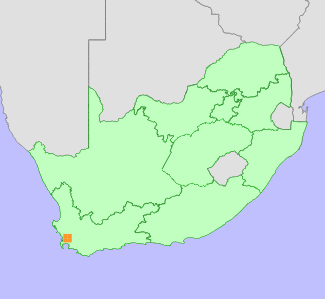|
Scientific Name | Babiana regia (G.J.Lewis) Goldblatt & J.C.Manning |
Higher Classification | Monocotyledons |
Family | IRIDACEAE |
Synonyms | Babiana stricta (Aiton) Ker Gawl. var. regia G.J.Lewis |
National Status |
Status and Criteria | Critically Endangered B2ab(i,ii,iii,iv,v) |
Assessment Date | 2022/10/25 |
Assessor(s) | P. Goldblatt, D. Raimondo & L. von Staden |
Justification | Six small, severely fragmented subpopulations remain on isolated lowland renosterveld fragments. The sizes of these fragments range between 0.4 and 2 km², and add up to a total AOO of <10 km². The small population, numbering less than 1000 mature individuals, continues to decline due to ongoing habitat loss and degradation. This species is therefore listed as Critically Endangered under criterion B. |
Distribution |
Endemism | South African endemic |
Provincial distribution | Western Cape |
Range | This species is endemic to South Africa, and is restricted to the extreme southwestern corner of Western Cape, in lowlands between Malmesbury and Stellenbosch. |
Habitat and Ecology |
Major system | Terrestrial |
Major habitats | Swartland Shale Renosterveld, Swartland Granite Renosterveld, Boland Granite Fynbos, Swartland Alluvium Fynbos |
Description | It grows in seasonally damp, well-drained sandy and gravelly slopes and flats. |
Threats |
| Less than 5% of this species' renosterveld habitat remains intact after extensive losses to crop cultivation. Only small, isolated fragments remain, which continue to be lost and degraded due to ongoing development, inappropriate fire management, spreading alien invasive plants, heavy grazing, eutrophication and herbicide drift from crop fields, and sand mining. Its habitat is largely given over to agriculture and it is now limited to only a few, small sites that no longer represent viable habitats. |
Population |
There are six known remaining subpopulations. The largest two consists of between 200 - 300 plants and 1000 plants (2006 record in Eensaamheid (Briers Louw) Nature Reserve, Paarl), while the others all number between 10 and 100 mature individuals. Only one subpopulation occurs in a small provincial protected area, and monitoring of this subpopulation indicates significant decline over the years. Five of the six subpopulations occur on small, isolated renosterveld remnants, ranging in size from 0.4-2 km². The population continues to decline due to ongoing habitat loss and degradation.
|
Population trend | Decreasing |
Assessment History |
Taxon assessed |
Status and Criteria |
Citation/Red List version | | Babiana regia (G.J.Lewis) Goldblatt & J.C.Manning | CR B1ab(ii,iii)+2ab(ii,iii) | Raimondo et al. (2009) | |
Bibliography |
Goldblatt, P. and Manning, J.C. 2004. Taxonomic notes and new species of the southern African genus Babiana (Iridaceae: Crocoideae). Bothalia 34(2):87-96.
Goldblatt, P. and Manning, J.C. 2007. A revision of the southern African genus Babiana, Iridaceae, Crocoideae. Strelitzia 18:1-97. South African National Biodiversity Institute, Pretoria.
Goldblatt, P. and Manning, J.C. 2020. Iridaceae of southern Africa. Strelitzia 42. South African National Biodiversity Institute, Pretoria.
Raimondo, D., von Staden, L., Foden, W., Victor, J.E., Helme, N.A., Turner, R.C., Kamundi, D.A. and Manyama, P.A. 2009. Red List of South African Plants. Strelitzia 25. South African National Biodiversity Institute, Pretoria.
|
Citation |
| Goldblatt, P., Raimondo, D. & von Staden, L. 2022. Babiana regia (G.J.Lewis) Goldblatt & J.C.Manning. National Assessment: Red List of South African Plants version 2024.1. Accessed on 2025/12/10 |
 Comment on this assessment
Comment on this assessment


